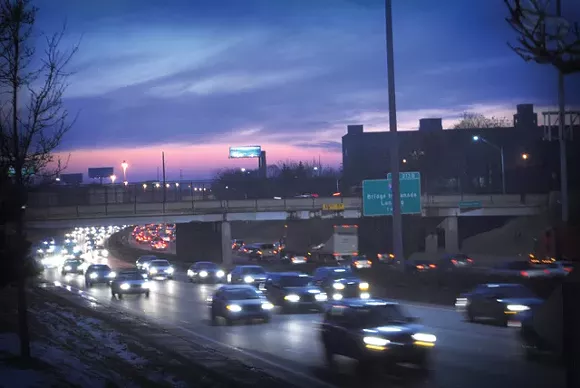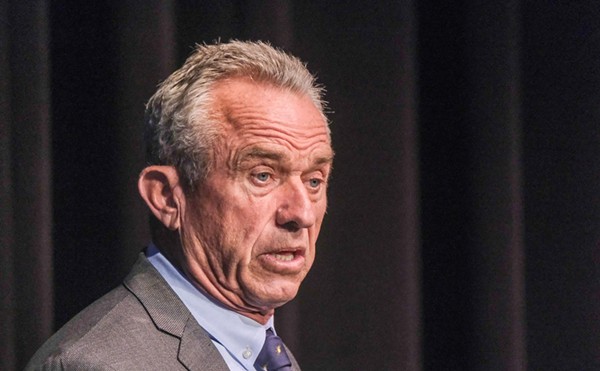
Ryan Felton/Metro Times
The plan to expand I-94 includes the removal of overpasses like the Trumbull Avenue bridge seen here.
This rag has long paid ample attention to one of the Michigan Department of Transportation’s largest pipe projects: The $2.7 billion proposal to widen I-94 one lane in each direction in Detroit. And just weeks after a national study called the proposal to widen I-94 a “boondoggle,” a state representative has introduced a bill that would ban any spending on the project.
State Rep. Jim Townsend (D-Royal Oak), introduced House Bill 5883, which would prohibit the Michigan Department of Transportation (MDOT) from spending approximately $4 billion to tackle the expansion of I94 in Detroit and I75 in Oakland County.
“These freeway expansions are an epic waste of money,” Townsend said in a statement. “At a time when we should be investing our scarce road dollars on fixing the roads we already have, MDOT is instead pursuing a freeway expansion that will weaken our economy and saddle taxpayers with new lanes to maintain in the future.”
Townsend adds: “We could literally repair every pothole in southeast Michigan with the amount of money the state wants to waste on these two projects.”
For years, MDOT has put forth the proposal to widen a 6.7mile stretch of I-94 in Detroit one lane in each direction, as well as I-75 from Eight Mile Road to M-59. The state says both projects are needed to alleviate rushhour congestion and would make the roads safer. Critics like Townsend counter, saying that an additional lane would be useless — that it’s of a mindset that represents an autocentric frame of mind from years past.
MDOT does share some common ground with opponents: Both sides agree the roadways need serious infrastructure repairs, but Townsend and others question why additional taxpayer dollars should be spent on widening the freeways.
“There’s no question that areas of 94 and 75 need to be improved,” Townsend tells the Hits, adding, “what doesn’t make sense is to tie to ... an expansion of capacity when our road use and our driving is shrinking.”
That claim was boosted in a report released last month by the U.S. Public Interest Research Group (PIRG). One of the issues the report takes with MDOT’s decision to widen I94 is that it’s based on outdated forecasts and projections from 2003, which show vehicle miles traveled would spike 11 percent by 2005.
Of course, that hasn’t been the case. PIRG points out, “these miles had already fallen 14 percent by 2013.”
With the I-94 project, some critics also point out that the freeway would cut off the thriving Midtown neighborhood from New Center at a time when the area is enjoying a resurgence of investment. And, in doing so, a number of buildings — such as the historic United Sound Systems recording studio on Second Avenue — would have to be demolished to facilitate the project.
“We should be investing in Michigan’s future by rebuilding the infrastructure we have, not throwing more money at failed transportation policies straight out of the 1960s,” says Townsend. “We know that doesn’t work.”
A significant part of the opposition is basically this: At a time more people — Young People(!) — are clamoring for more efficient public transit, why does the state want to invest heavily in a project that will put metro Detroit’s two busiest freeways under construction for decades? By MDOT’s estimate, these projects won’t be completed until the late 2020s and into the 2030s.
That sort of “disruption to our economy” would include a diversion of traffic off of I-75 and onto local, tattered streets, “for years and years,” Townsend points out.
The lawmaker also has plenty of time to witness exactly just how much congestion builds up on I-94. In his spare time from Lansing, Townsend says he’s been pursuing his law degree at Wayne State University, taking night classes.
He says he parks past the Cass Avenue bridge over I-94 — one of the many overpasses that would be removed in the project — right around the nighttime rush hour. What’s the scene of I94 from his birds-eye view? Eastbound I94 isn’t even congested, he says, and westbound traffic “would barely even qualify as busy.” Certainly, he says, not busy enough to justify spending over $2 billion to widen the road.
In response to a request for comment on Townsend’s bill, MDOT pushed back, saying the segments of I-75 and I-94 in question, and many overpasses, are in “severe need of rebuilding.”
“If they are to be rebuilt, it only makes sense to plan for future needs,” MDOT says.
With the I-94 project, MDOT says no more than 20 percent of the costs would be spent on additional roadway; for I-75, it’s estimated to be about 2 percent. Using those figures, that would roughly work out to approximately $880 million. By comparison, the original proposal for a light-rail line along Woodward Avenue, from Jefferson Avenue to Eight Mile Road, was estimated to be only $500 million. On top of that, projected operating costs for that nowshelved transit project would’ve been covered for 25 years.
But, MDOT says, “when the study is done, that could be less.”
“Both are extremely important commercial corridors, vital to businesses [that] rely on trucking in an era of just in time delivery,” MDOT adds. “It’s all about balance. MDOT is a multimodal department, supporting Complete Streets, the M1 Rail project on Woodward Avenue, the establishment of an RTA (50 years in the making), and just this week, helping DDOT buy 50 new buses. Still, there is nothing to indicate that freeways will not remain an important part of metro Detroit’s transportation system.”
Townsend’s criticism was boosted last month by the recent U.S. Public Interest Research Group study that labeled the I94 project one of the nation’s worst “highway boondoggles” in the works.
The national watchdog group’s study called into question lawmakers' contention that such projects are needed at a time when American driving trends have drastically changed.
For instance, since 2005, the total number of miles Americans drive has dropped 7 percent, the report notes. Even so, our state and federal government continue to spend billions on highway projects “based on... obsolete assumptions, wrote Phineas Baxandall, U.S. PIRG senior analyst and coauthor of the report, in a prepared statement.
MDOT says a consultant is gathering “uptodate” traffic data, and will receive a recommendation on lane configurations — that is, whether additional lanes are needed — within the next three months.
Critics also highlight the phenomenon known as “induced demand” — in essence, the idea that if you build additional lanes, the freeway will eventually attract more motorists, requiring the supposed need for more lanes, and so on — would likely quash any projections that simply widening the freeway one lane will ease bottlenecks during peak hours.
In response to Metro Times questions last year about the possibility that induced demand could be a factor in the future, an MDOT official said they understand the concept and that, “sure, there might be more traffic, but there is the need for the roadway now.”
This isn’t an issue that only Townsend’s kin takes issue with: The representative’s bill has attracted bipartisan support, according to a news release, with 17 representatives signing on as cosponsors.
The bill has been referred to the House Transportation and Infrastructure Committee for consideration. Townsend tells the Hits that any proposed funding package to fix roads will likely be met with some resistance by the group of lawmakers behind his bill.
“We want to send a signal that ... our votes are going to be dependent on whether there’s assurance these projects that don’t make any sense won’t receive any funding,” he says, adding there should be additional dollars spent on public transit, another way some note would get motorists off the road.
With the region’s longterm troubles with public transit, we can’t find reason to argue with that logic.






